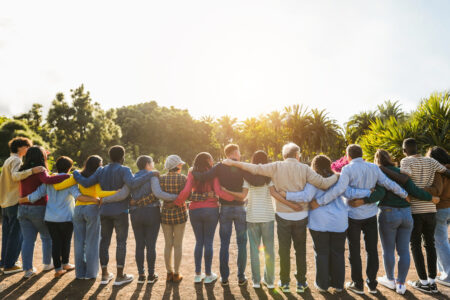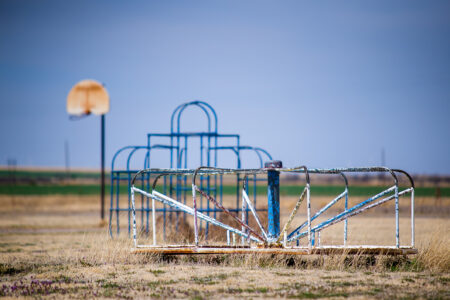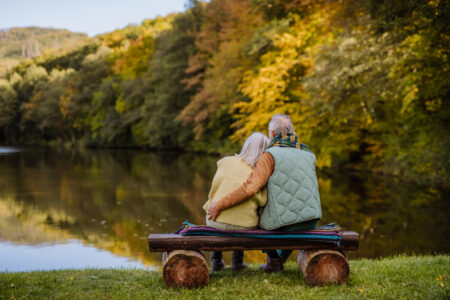Share On Social!
Having limited resources, partnerships and community involvement played a key role in transforming old train tracks into the Belden Trail in West Brownsville, a largely Latino town in Texas. A physician-turned-city-leader worked with community leaders and discussed ways to improve the quality of life for residents living in one of the most underserved and neglected regions of the city that lacks spaces for physical activity. The team’s persistence and belief in how this trail could transform the community helped them secure a statewide rails-to-trails grant. But the story doesn’t end there. Recently, the city added ADA approved sidewalks leading to nearby bus stops, developed a master hike and bike plan, and is planning for a community garden. Through teamwork and dedication to an important cause, permanent improvements and healthy changes can occur.
EMERGENCE
Awareness: Increased rates of chronic disease and obesity were of growing concern to Drs. Rose Gowen and Belinda Reininger, both professors at the University of Texas School of Public Health in Brownsville.
They were especially alarmed by the high adult obesity rate (>50%) and with the growing trend of obesity among children in Brownsville.
“As a physician I knew there was a lot of diabetes, but when I saw the numbers (31%) they really stunned me,” Gowen said. “One of the things that struck me was the high diabetes prevalence among those with tuberculosis.”

Learn: Gowen and Reininger said high poverty rates, limited access to healthy food, and a lack of parks and places of recreation are top concerns in Brownsville—which sits at the southern-most tip of Texas alongside the Mexican city of Matamoros, Tamaulipas.
So Gowen and Reininger decided to team up with key stakeholders to organize activities to improve the community’s health.
They wanted to focus their efforts on initiatives that would create a lasting impact on the community so they first set out to create the Brownsville Farmer’s Market (est. 2008) and then a city-wide, yearly Biggest Loser Challenge (est. 2010), to encourage healthier lifestyles among residents.
Determined to see the health of the citizens of Brownsville continue to improve, Gowen decided to run for public office. She ran on the slogan, “it’s time for healthy change,” and in 2009 was elected to the position of city commissioner.
Gowen wanted to increase the amount of publicly accessible active spaces so she became the chair of the Brownsville Community Improvement Corporation (BCIC)—an organization that funds quality of life projects using a ¼ cent Section 4B economic development sales and use tax that was approved by voters in 2001.
Frame Issue: At BCIC meetings, the group discussed bringing a hike and bike trail to West Brownsville. The then- director of the BCIC alerted Gowen to a rails-to-trails grant from the Texas Parks and Wildlife Department (TPWD) that could provide up to 80% of the funds needed to build a trail.
Gowen and the BCIC board agreed that this was a great opportunity for the city, so they began to work with city employees to search for an area that could benefit from this trail the most.
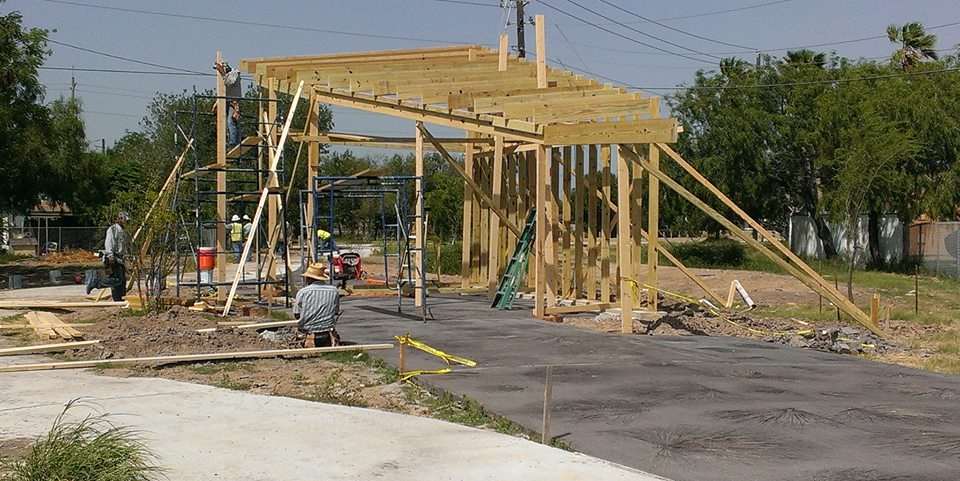
BCIC staff, including current executive director Rachel Flores, began working with the city’s engineering department and a right-of-way specialist to see what land was available.
The team looked at maps and soon learned that property on the West side of Brownsville, which had formerly belonged to Union Pacific, now belonged to the city of Brownsville, and that t
rain tracks had been removed from the property in the late 1990s.
According to the Brownsville Herald, Flores said: “We came across a map showing the original street name [Belden], and found out that the 100-year lease had just expired, thereby reverting ownership back to the city of Brownsville.” The area also was home to a population-dense, low-income neighborhood that was near two schools and two parks.
Flores contacted Maggie Winter, a community designer with BC Workshop—a non-profit community design center that uses public design and public engagement to improve communities’ livability and viability—for help designing a possible asphalt trail in this location with benches and bollards. Winter and the team at BC Workshop were happy to get involved.
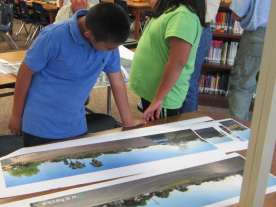
The idea of improving the city’s built environment and creating city wide bike trails was not a new one, the city’s Metropolitan Planning Organization (MPO) and planning department had already talked about creating bike trials in Brownsville, but plans to proceed were halted due to a lack of funding.
“If we could successfully develop a rails-to-trails project that might help,” Flores said.
DEVELOPMENT
Education: According to Flores and Winter, in years prior Brownsville had not paid much attention to how projects like this could help improve the health of the community. There had also been a lack of community input so the group wanted to be sure to get as much feedback from the community as possible.
Flores, Winter and others made plans to work with nearby schools from the Brownsville Independent School District (BISD) to host planning workshops for the community.
“We wanted to invest in a project that would help the most people, be centralized in a low income neighborhood, and not be too expensive as a property acquisition,” Flores said. “We wanted to show the city that it is was possible [to have the trail built] and that community support was there.”
Winter added: “Everything we do has an element of community engagement.”
After locating the site of the new trail and speaking with designers from the BC Workshop, the group presented their ideas to BISD administrators. They explained how this trail would provide students with a safe path to encourage walking and how it would help beautify the community. It would also increase the area’s connectivity with parks and the downtown area.
Administrators with BISD were delighted to learn of the plans for this trail and offered their support however they did have some questions as to how the trail would impact parking at a nearby high-school football stadium.
Still, the district agreed to host community planning sessions at two schools and to send out invitations to parents about these meetings.
“On a local level, the principal at Skinner was very excited about the project,” Flores said.
Mobilization: By this point the group was generating community support for the location and construction of an asphalt trail with benches and bollards. So the City of Brownsville, in 2011, submitted these ideas in an application in 2011 for the TPWD grant.
However, the project was not selected for funding. Gowen reviewed the application with TPWD officials.
“I sat down with him [the TPWD representative] and learned a bit more about the grant itself. He said, ‘Well it’s only a 1-mile trail.’ But I explained it goes through one of the poorest sections, and it’s an important connector from east to west,” Gowen said.
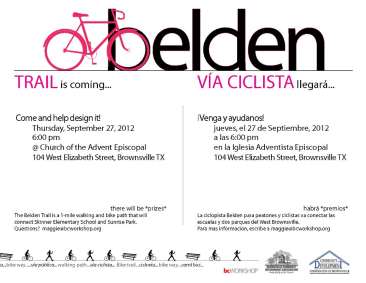 After getting a few supportive pointers from the TPWD, the city revised its application, increased its amount of matching funds, and reapplied for the grant in 2012.
After getting a few supportive pointers from the TPWD, the city revised its application, increased its amount of matching funds, and reapplied for the grant in 2012.
This time the Belden trail was funded.
“Tenacity is important,” Flores said.
Debate: Now that funding would be available for the trail, Flores and Winter arranged a series of six bilingual public meetings between July through December of 2012. Families attended meetings at two BISD elementary schools (Skinner and Sharpe) and at a local church located near the Belden Trail.
“We learned a lot from the community,” Winter said. “For instance, they were not aware of a park that was located nearby. We also learned that they were concerned about safety and they wanted shade for the trail. Shade was a big thing.”
As plans for the trail continued to develop, the BCIC approached the BISD board of trustees to discuss how the new trail might impact parking at the nearby high-school football stadium.
“We gave the BISD admin and board a presentation on possible alternative parking for their buses during football games and also held a meeting with the superintendent, mayor and Rose [Gowen] to talk about how the trail was a pilot and how this fit in to the city’s overall growth and development,” Flores said.
The board agreed to enter into an agreement which would allow the city to use the easement for the trail.
ENACTMENT
Activation: The BC Workshop then started working on the trail design.
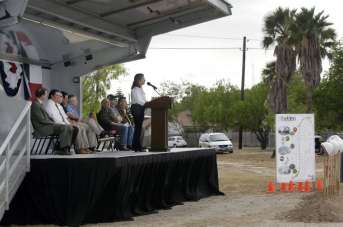 The BCIC approached BISD officials to discuss using a portion of their land for the trail’s landscaping and the need to relocate where the district would park some of its school buses.
The BCIC approached BISD officials to discuss using a portion of their land for the trail’s landscaping and the need to relocate where the district would park some of its school buses.
“We came to them [the district] with the idea and invited them to participate early on, communication was what made this project successful,” Winter said. “And there was more time to work out any kinks.”
Because the BCIC and BC Workshop worked closely with the city to obtain permits to begin construction, word about the Belden Trail reached Norma Zamora, director for Brownsville Metro (B Metro).
B Metro was working on installing ADA-approved sidewalks near bus stops around the city, so Zamora offered to use some of B Metro’s federal grant funding to build new sidewalks along streets surrounding the trail.
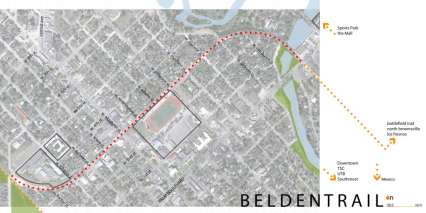
Frame policy: Final plans for the Belden trail include:
- A one-mile asphalt trail with bollards
- Twelve benches
- Two pavilions
- 100 native trees along the trail for shade
- An area to park bikes
The trail is located near two elementary schools, a sports park and high-school football stadium.
Change: In May 2012, the City of Brownsville was awarded a $151,274 grant from the TPWD to construct the Belden Trail.
On March 21, 2013, a groundbreaking ceremony for the Belden Trail was held near Skinner Elementary.
Families and children from Skinner elementary attended the ceremony.
The ribbon cutting ceremony for the opening of the new trail was scheduled for September 26, 2013.
IMPLEMENTATION
Implementation: Once the trail becomes a reality, Gowen expects it to significantly increase the availability and connectivity of active spaces for residents in Brownsville.
Building this trail couldn’t come at a better time. Partners and community members across the city are ready to experience change.
According to Gowen, pediatric residents from Community for Children—a pediatrics training initiative that seeks to train future physicians about addressing social inequities in child health—received a grant (Bikes for Tykes) to get kids on bikes and are now working with the local Parks and Recreation Department to implement a bike program at the Belden Trail.
“The success of our efforts to secure funding from state and federal sources for this project, i.e. not local tax monies, should encourage us to continue this same pattern of planning and collaboration,” said Gowen, according to a blog post from United Brownsville, during her speech at the groundbreaking ceremony.
Meanwhile, Reininger has already developed plans and acquired funds to develop a community garden along the trail.
According to a news article published in the Brownsville Herald, Flores said: “What we would really like to do is a community garden, especially since Skinner doesn’t have a very big playground. We want things that will induce children to be more active outside.”
Equity: Thanks to the partnership with B-Metro new ramps and sidewalks that meet American Disabilities Act (ADA) standards will provide access to bus stops near the Belden Trail. This will not only increase ADA accessibility but also help increase safety and mobility for West Brownsville residents.
Along with these improvements, the city of Brownsville recently announced plans for a new bus route that would connect regions of the South Texas Valley. The routes would service Brownsville, South Padre Island, the University of Texas-Pan American and McAllen.
Sustainability: According to an article from the Brownsville Herald, the city is also making strides with its master hike and bike plan. Recently, Brownsville received a $746,403 grant from the federal transportation enhancement program to build an additional 2.75 miles of trails, which will connect three historic battlefields.
With continued dedication, team work and a spirit of enthusiasm to improve Brownsville’s health, residents living in this South Texas community are making progress towards more active living.
Additional Links:
Update! Brownsville is Selected as one of Six RWJF Culture of Health Prize Winners for 2014
Study: Cross-sectional assessment reveals high diabetes prevalence among newly-diagnosed tuberculosis cases
Brownsville city commissioners trying to fight obesity with farmers market (2011)
News Center 23 report: Studies Show 50% of Brownsville Population Falls into Obese Category
TPWD news release: $3 Million in Trail Grants Awarded Across Texas May 24, 2012
News articles from the Brownsville Herald:
Expert: Many unaware they have condition
Parks & Wildlife grant to restore old rail line June 12, 2012,
Belden Trail takes strides January 2, 2013,
Belden Trail off and running March 21, 2013,
City rolls out conceptual master hike & bike plan for trails April 13, 2013
Event Speech: “The Long Road to the Belden Trail: How it happened?” March 21, 2013
BCIC Public Hearing Notice for Community Garden Project
Transit officials tout bus service’s new Valleywide connections
This success story was produced by Salud America! with support from the Robert Wood Johnson Foundation.
The stories are intended for educational and informative purposes. References to specific policymakers, individuals, schools, policies, or companies have been included solely to advance these purposes and do not constitute an endorsement, sponsorship, or recommendation. Stories are based on and told by real community members and are the opinions and views of the individuals whose stories are told. Organization and activities described were not supported by Salud America! or the Robert Wood Johnson Foundation and do not necessarily represent the views of Salud America! or the Robert Wood Johnson Foundation.
ABOUT THE PROGRAM
Salud America! The RWJF Research Network to Prevent Obesity Among Latino Children is a national program of the Robert Wood Johnson Foundation. The program aims to educate researchers, decision-makers, community leaders, and the public in contributing toward healthier Latino communities and seeking environmental and policy solutions to the epidemic of Latino childhood obesity. The network is directed by the Institute for Health Promotion Research at the University of Texas Health Science Center at San Antonio.
For more information, visit http://www.salud-america.org.
By The Numbers
33
percent
of Latinos live within walking distance (<1 mile) of a park
This success story was produced by Salud America! with support from the Robert Wood Johnson Foundation.
The stories are intended for educational and informative purposes. References to specific policymakers, individuals, schools, policies, or companies have been included solely to advance these purposes and do not constitute an endorsement, sponsorship, or recommendation. Stories are based on and told by real community members and are the opinions and views of the individuals whose stories are told. Organization and activities described were not supported by Salud America! or the Robert Wood Johnson Foundation and do not necessarily represent the views of Salud America! or the Robert Wood Johnson Foundation.

